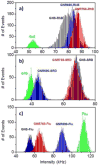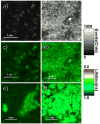An ultra-sensitive dual-mode imaging system using metal-enhanced fluorescence in solid phantoms
- PMID: 26870306
- PMCID: PMC4745124
- DOI: 10.1007/s12274-015-0891-y
An ultra-sensitive dual-mode imaging system using metal-enhanced fluorescence in solid phantoms
Abstract
In this study we developed a highly sensitive dual modal imaging system designed for gold nanoparticles (GNPs) conjugated to various fluorophores in solid phantoms. The system consists of fluorescence lifetime imaging microscopy (FLIM) for surface imaging, diffusion reflection (DR) for deep tissue imaging (up to 1cm), and metal enhanced fluorescence (MEF). We detected quenching in fluorescent intensity (FI) for the conjugation of gold nanospheres (GNS) as well as gold nanorods (GNRs) to Fluorescein, which has an excitation peak at a wavelength shorter than the surface plasmon resonance (SPR) of both types of GNPs, and enhanced FI in conjugation to Rhodamine B and Sulforhodamine B, both with excitation peaks in the GNPs' SPR. The enhanced FI was detected in solution as well as in solid phantoms from FLIM measurements. DR measurements detected GNR presence within the solid phantoms by recording dropped rates of light scattering using wavelengths corresponding to the GNRs' absorption. With the inclusion of MEF, this promising dual modal imaging technique enables efficient and sensitive molecular and functional imaging.
Keywords: Gold nanoparticles; biomolecular imaging; diffusion reflection; fluorescence lifetime imaging; metal enhanced fluorescence; noninvasive detection.
Figures







References
-
- Cao YC, Jin R, Mirkin CA. Nanoparticles with Raman spectroscopic fingerprints for DNA and RNA detection. Science. 2002;297:1536–1540. - PubMed
-
- Rosi NL, Mirkin CA. Nanostructures in biodiagnostics. Chem Rev. 2005;105:1547–1562. - PubMed
-
- Nie S, Xing Y, Kim GJ, Simons JW. Nanotechnology applications in cancer. Annu Rev Biomed Eng. 2007;9:257–288. - PubMed
Grants and funding
LinkOut - more resources
Full Text Sources
Other Literature Sources
